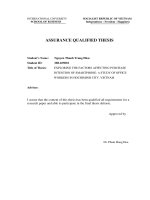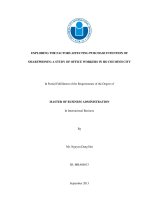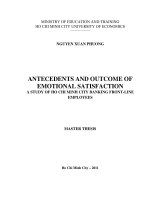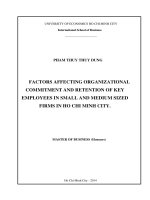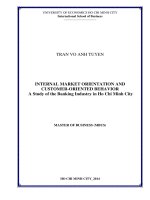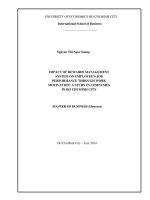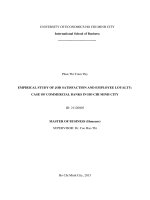Key factors contributing to employee engagement a study in ho chi minh city export processing zones and industrial parks
Bạn đang xem bản rút gọn của tài liệu. Xem và tải ngay bản đầy đủ của tài liệu tại đây (1.16 MB, 75 trang )
UNIVERSITY OF ECONOMICS HO CHI MINH CITY
International School of Business
------------------------------
Le Thi Hoang Lan
KEY FACTORS CONTRIBUTING
TO EMPLOYEE ENGAGEMENT:
A study in Ho Chi Minh City Export
Processing Zones and Industrial Parks
MASTER OF BUSINESS (Honours)
Ho Chi Minh City – Year 2014
UNIVERSITY OF ECONOMICS HO CHI MINH CITY
International School of Business
------------------------------
Le Thi Hoang Lan
KEY FACTORS CONTRIBUTING
TO EMPLOYEE ENGAGEMENT:
A study in Ho Chi Minh City Export
Processing Zones and Industrial Parks
ID: 21110012
MASTER OF BUSINESS (Honours)
SUPERVISOR: Dr. CAO HAO THI
Ho Chi Minh City – Year 2014
i
ACKNOWLEDGEMENT
Firstly, I would like to express my sincere gratefulness to my supervisor Dr. Cao Hao Thi for
his professional guidance, valuable support, intensive advice, continuous encouragement that
he gave me during the time doing this research.
Secondly, I would like to express my deepest gratitude to Professor Nguyen Dong Phong,
Professor Nguyen Dinh Tho, and Dr. Tran Ha Minh Quan for their valuable time as the
members of ISB Research Committee (IRC). All of their critical comments and suggestions
have contributed significantly for me to complete this research.
My truly thanks are also given to my ISB classmates as well as all people I know who
participated in filling the questionnaires and provided the valuable information for this study.
Last but not least, I would like to express my sincere thanks to all professors at ISB for their
teaching and guidance during my last two-year master course.
Le Thi Hoang Lan
February 2014.
ii
ABSTRACT
This study attempts to examine key factors contributing to the engagement of employees,
who are working in export processing zones and industrial parks in Ho Chi Minh City. In
details, it examines the impact of the five factors (Supervisor support, Training, Rewards and
Recognition, Working environment, and Job characteristics) on employee engagement.
Based on this objective, a survey was delivered to target respondents and among five
independent factors, the study explored positive effect of the four independent variables on
employee engagement. They were Supervisor support, Training, Working environment, and
Job characteristics. Besides, the Multiple Linear Regression and ANOVA analysis identified
the research model of this study could explain 51% of the total variance in employee
engagement and ANOVA testing result also showed that there was significant difference in
terms of gender (between male and female) on the engagement of employees. The findings
also figured out supervisor support factor seemingly play a crucial role on the engagement of
employees.
As a result, in order to achieve high employee engagement, companies in export processing
zones and industrial parks in Ho Chi Minh City might need of paying more attention on
nurturing the relationship between employees and their supervisors, providing better training
programs, working environment, and job design. Practical and managerial implications are
also further discussed in this study.
iii
TABLE OF CONTENTS
ACKNOWLEDGEMENT .......................................................................................................... i
ABSTRACT ...............................................................................................................................ii
TABLE OF CONTENTS ..........................................................................................................iii
LIST OF FIGURES ................................................................................................................... v
LIST OF TABLES .................................................................................................................... vi
LIST OF ABBREVIATIONS ..................................................................................................vii
CHAPTER 1: INTRODUCTION .............................................................................................. 1
1.1. Research background ...................................................................................................... 1
1.2. Research problem............................................................................................................ 2
1.3. Research objectives ......................................................................................................... 3
1.4. Research scope and research methodology..................................................................... 4
1.5. Research contribution ..................................................................................................... 4
1.6. Research structure ........................................................................................................... 4
CHAPTER 2: LITERATURE REVIEW ................................................................................... 6
2.1. Employee engagement .................................................................................................... 6
2.2. Key factors contributing to employee engagement ........................................................ 8
2.2.1. Supervisor support .................................................................................................. 8
2.2.2. Training ................................................................................................................... 9
2.2.3. Rewards and recognition......................................................................................... 9
2.2.4. Working environment ........................................................................................... 10
2.2.5. Job characteristics ................................................................................................. 10
2.3. The research model ....................................................................................................... 12
CHAPTER 3: RESEARCH METHODOLOGY ..................................................................... 13
3.1. Research process ........................................................................................................... 13
3.2. Measurement scale ........................................................................................................ 14
3.3. Data collection methods ................................................................................................ 16
3.3.1. Preliminarily qualitative research (In-dept interview) .......................................... 16
3.3.2. Quantitative research ............................................................................................ 16
3.3.3. Main survey .......................................................................................................... 17
3.4. Sampling design ............................................................................................................ 17
3.4.1. Population ............................................................................................................. 17
3.4.2. Sample size ........................................................................................................... 18
3.4.3. Sampling technique ............................................................................................... 18
iv
3.5. Data analysis methods................................................................................................... 19
3.5.1. Statistical Method ................................................................................................. 19
3.5.2. Descriptive Statistic .............................................................................................. 19
3.5.3. Reliability analysis ................................................................................................ 19
3.5.4. Exploratory factor analysis ................................................................................... 19
3.5.5. Multiple regression analysis ................................................................................. 20
CHAPTER 4: RESULTS AND DISCUSSIONS .................................................................... 21
4.1. Sample descriptive statistics ......................................................................................... 21
4.2. Assessing the reliability of measurement scale ............................................................ 23
4.3. Assessing the validity of measurement scale ................................................................ 25
4.4. Multiple Linear Regression........................................................................................... 28
4.4.1. Test of assumptions............................................................................................... 28
4.4.2. Correlation analysis .............................................................................................. 29
4.4.3. Regression analysis ............................................................................................... 30
4.4.4. Hypotheses testing ................................................................................................ 31
4.6. Discussing the research results ..................................................................................... 34
CHAPTER 5: CONCLUSIONS AND IMPLICATIONS ....................................................... 37
5.1. Summary of findings..................................................................................................... 37
5.2. Managerial implications................................................................................................ 38
5.2.1. Supervisor support ................................................................................................ 38
5.2.2. Job characteristics ................................................................................................. 38
5.2.3. Working environment and Training...................................................................... 38
5.3. Limitations and future research direction ..................................................................... 39
References ................................................................................................................................ 41
APPENDICES ......................................................................................................................... 45
Appendix A: A back-tranlated version of questionnaire ......................................................... 45
Appendix B: Vietnamese-version questionnaire ..................................................................... 47
Appendix C: English-version questionnaire ............................................................................ 50
Appendix D: Comments from in-dept interview ..................................................................... 53
Appendix E: Rejected item(s) in Pilot test............................................................................... 58
Appendix F: Determinant, KMO and Bartett’s Test, Sree Plot, Total Variance Explained .... 59
Appendix G: Testing assumptions of mutilple linear regression ............................................. 61
Appendix H: Testing of moderating effects – Demographics (Gender/Age) .......................... 66
v
LIST OF FIGURES
Figure 2.1. The proposed research model ................................................................................ 12
Figure 3.1. Research process ................................................................................................... 14
Figure 4.1. The final research model ....................................................................................... 34
vi
LIST OF TABLES
Table 3.1. Measurement scale of employee engagement and factors contributing to employee
engagement .............................................................................................................................. 15
Table 4.1. Summary population of data collection .................................................................. 21
Table 4.2. Data collection methods.......................................................................................... 22
Table 4.3. Gender, Age, Position and Working experience of respondents ............................ 22
Table 4.4. Result of reliability analysis ................................................................................... 24
Table 4.5. Rotated Component Matrix .................................................................................... 27
Table 4.6. Correlations statistics .............................................................................................. 30
Table 4.7. Model summary of multiple linear regression analysis .......................................... 30
Table 4.8. ANOVA of multiple linear regression analysis ...................................................... 31
Table 4.9. Coefficients of multiple linear regression ............................................................... 32
Table 4.10. Summary results of testing hypotheses ................................................................. 34
vii
LIST OF ABBREVIATIONS
EPZs and IPs:
Export Processing Zones and Industrial Parks
HCMC:
Ho Chi Minh City
HEPZA:
Ho Chi Minh City Export Processing and Industrial Zones Authority
EFA:
Exploratory Factor Analysis
KMO:
Kaiser-Meyer-Olkin
ENGAGE:
Employee engagement
LEAD:
Supervisor support
TRAIN:
Training
REWARD:
Rewards and Recognition
ENVIR:
Working environment
JOB:
Job characteristics
1
CHAPTER 1: INTRODUCTION
1.1. Research background
There are perceptions in which organization must invest its time and effort. Employees who
are engaged in their work, involved in their job and committed to their organizations give
companies crucial competitive advantages—including higher productivity and lower
employee turnover. Thus, it is not surprising that organizations of all sizes and types have
invested substantially in policies and practices that foster these perceptions. However, they
are different as engagement drives commitment and involvement, whereas the reverse is not
possible, commitment cannot be achieved without engagement and involvement is not exist
among employees.
Many researches have shown that employees who are engaged tend to explore their
performance better than who are not engaged. Stated differently, an engaged employee is
aware of business context, and works with colleagues to improve performance within the job
for the benefit of the organization (Sundaray, 2011).
In addition, when employees are engaged, when they care more about their jobs, they are
willing to exert discretionary effort (Kruse, 2012) to get the required results. It means
engaged employees spend the voluntary effort that lies above the minimum level of effort
required to keep the job and is directed towards organizational goals (Lloyd, as cited in
Parrey & Bhasin, 2013). Further, work effectiveness is simultaneously higher where more
engaged employees work together. It tends to higher 94% in which departments have more
engaged employees as shown in the report of Dale Carnegie Training (2012). That means
engaged employees are more productive, give better service to customers, and stay in their
jobs longer.
2
Therefore, in the fight for competitive advantage where employees are the differentiator,
engaged employees are the ultimate goal (BlessingWhite, 2013). Employee engagement is
also considered as the most powerful factor to measure company’s vigour (Baumruk, as cited
in Anitha, 2012).
1.2. Research problem
Some researches have found out factors drive the engagement of employees in Vietnam. For
example, Do, Nguyen and Nguyen (2012) figure out five factors associated with the longterm engagement of young Vietnamese employees to organizations including promotion
opportunities, rewards and benefits policy, relationship with managers, working condition
and the consistency between their job and their career purpose. Among them, promotion
opportunities have the strongest impact (Do et al., 2012). From a study of the relationship
between job satisfaction and engagement of employees, Mai and Thai (2013) argue that in
order to achieve high employee engagement, companies should have high level of employee
job satisfaction, better compensations and benefits package, better working environment, and
better employee relationship with management.
Ho Chi Minh City is considered as a dynamic city offering a potential market. To meet the
requirements of economic, skilled labour is increasing dramatically, especially in export
processing zones (EPZs) and industrial parks (IPs). According to Ho Chi Minh City Export
Processing and Industrial Zones Authority (HEPZA), up to now, the EPZs and IPs have
attracted over 1.216 investment projects and have managed over 256.529 employees working
in these zones.
However, in recent years, after some public national holidays, especially Tet holiday,
Vietnamese employees tend not to return to work, or they leave their current job and seek
themselves another job. This issue has become a tendency happening in most of the
3
companies in the EPZs and IPs in HCMC. Although companies have some solutions such as
increasing salary, offering some benefit (bonus, health insurance, etc.) to remain employees
and attract more labor, the number of employees is still lower than demand (Mai & Thai,
2013). It is considered as an unsolvable problem that lets many companies face with
difficulties to maintain production process. Therefore, it is not hard to realize that in order to
survive in long-term, companies need to think how to maintain the engagement of their
current employees. Moreover, as stated by Mr. Nguyen Tan Dinh, Vice Chairman of HEPZA
(2012), to meet business’s requirements of the EPZs and IPs as well as to enhance the quality
of human resources, there is a close interaction between HEPZA and universities/colleges in
order to train and provide more skilled labor, especially high-quality workforce.
Consequently, understanding the engagement of employees will help the EPZs and IPs not
only maintain engaged employees to their organization, produce effectiveness of employees’
outcomes (i.e. productivity, loyalty, commitment) but also help enhance high-quality
workforce for competitive advantage. Stated differently, a topic related to key factors
contributing to employee engagement in the EPZs and IPs in HCMC is necessary to deploy.
1.3. Research objectives
Based on research background and research gap, the overall objective of this study is to
examine key factors associated with employee engagement as well as the strength of each
factor on employee engagement. In specific, this study aims to investigate:
-
The contribution of supervisor support on the engagement of employees.
-
The contribution of training on the engagement of employees.
-
The contribution of rewards and recognition on the engagement of employees.
-
The contribution of working environment on the engagement of employees.
-
The contribution of job characteristics on the engagement of employees.
4
1.4. Research scope and research methodology
This study is merely conducted in HCMC, one of the biggest economic centers of Viet Nam.
The target respondents are Vietnamese employees working in companies or enterprises in the
EPZs and IPs in HCMC.
About the research methodology, this study includes both qualitative and quantitative
research and primary data are collected based on questionnaire survey. For the data analysis,
this study uses the Statistical Package for Social Science software (SPSS) to analyze the data
analysis such as Graphs, Descriptive Statistics, Reliability analysis (Cronbach’s Alpha),
Exploratory Factor Analysis, and Multiple Linear Regression to test the relationship between
independents variables and the dependent variable.
1.5. Research contribution
The research findings might help companies or firms in the EPZs and IPs in HCMC
understand their employee engagement and have a deep awareness about key factors
contributing to their employee engagement. Therefore, they may know how to maintain their
employees more effectively. Likewise, based on the research results, this study hopes to
provide practical contributions to help managers build a strategic plan for working towards
increasing the engagement of employees.
1.6. Research structure
The research compounds five chapters from Chapter 1 to Chapter 5 as following:
Chapter 1 - Introduction introduces the research background, clarifies the research gap then
raises the research problem, research objectives, research methodology, research scope, and
contributions of the research.
Chapter 2 – Literature Review presents theoretical concepts and proposes the research
model. In this chapter, research hypotheses are also discussed.
5
Chapter 3 - Research Methodology presents in more details the research process, the
measurement scales, questionnaire design, sampling design and the data analysis methods.
Chapter 4 – Results and Discussions expresses all results of the research. This is the most
important part of the research including Sample Descriptive Statistics, Reliability Analysis,
Exploratory Factor Analysis, and Multiple Regression Analysis. In this chapter, a discussion
of the research’s findings is also presented to provide a comprehensive picture about the
contribution of factors affecting to employee engagement in the context of EPZs and IPs in
HCMC.
Chapter 5 - Conclusions and Implications presents a conclusion of the findings in the
study, suggests managerial implications based on the results of previous chapters, and gives
limitations that impact on the findings as well as future research direction.
6
CHAPTER 2: LITERATURE REVIEW
This chapter aims to present an overview of which literature related to employee engagement
concept and factors affecting employee engagement including definitions and evidences from
previous studies. In this chapter, a proposed research model as well as research hypotheses
are also developed.
2.1. Employee engagement
In recent years, employee engagement has become an interesting topic because better
services, better products, high technologies or better strategies can make one company more
successful than another but all of them can be copied over time (Dale Carnegie Training,
2012). The only thing that creates sustainable competitive advantage is the workforce, the
people who are working for the company.
According to Markos and Sridevi (2010), there is no single and generally accepted definition
for the term employee engagement. Moreover, definitions of employee engagement have
been written in practical journals rather than theories and empirical researches (Saks, 2006).
In business, employee engagement is the emotional commitment that the employee has to the
organization and its goals (Kruse, 2012). As suggested by Kruse, this emotional commitment
means engaged employees actually care about their work and their company, work for the
organization’s goals instead of working just for a salary, or just for promotion. It means that
engaged workers love their job and want to finish their job as effective as possible. They even
try to solve difficulties that they face to in job, and of course, they would introduce their
company and product of company to people they know (Kruse, 2012).
Kahn (1990), one of the foremost researchers to introduce the concept (Anitha, 2012), defines
employee engagement as the harnessing of organization members’ selves to their work roles.
As defined by Kahn, there are three aspects of employee engagement (physical aspect,
7
cognitive aspect and emotional aspect). Kahn also adds three psychological engagement
conditions that are necessary for an employee to be rightly engaged: meaningfulness (work
elements), safety (social elements, including management style, process and organizational
norms) and availability (individual distractions).
Harter, Schmidt, and Hayes (2002) view employee engagement as the individual's
involvement and satisfaction with as well as enthusiasm for work.
Robinson, Perryman and Hayday (2004) define employee engagement as a positive attitude
held by the employee towards the organization.
Saks (2006) approaches this concept from a multidimensional perspective. As defined by
Saks (2006), employee engagement is a distinct and unique construct that consists of
cognitive, emotional, and behavioral components that are associated with individual role
performance.
Sundaray (2011) supposes employee engagement is the level of commitment and
involvement an employee has towards their organization and its values.
In academic, according to Markos and Sridevi (2010), the construct employee engagement is
built on the foundation of earlier concepts like job satisfaction, employee commitment and
organizational citizenship behavior. Thus, it is stronger predictor of positive organizational
performance as well as clearly showing the two-way relationship between employer and
employee compared to the three earlier concepts. Engagement takes place when employees
show interest in their jobs and are willing to exert an extra discretionary effort to get the
required results (Macey & Schneider, 2008). That means engagement is not for the
organization and comes from the internal motivation; however, the benefits do reach the
organization. Consequently, engaged employees are highly involved in their job with a great
enthusiasm for the success of their employer as well as seemingly going extra mile beyond
the employment contractual agreement.
8
2.2. Key factors contributing to employee engagement
2.2.1. Supervisor support
Supervisor support is defined as the extent to which leaders value their employees’
contributions and care about their well-being (Powell, 2011). Rhoades and Eisenberger
(2002) suppose that since supervisors act as agents of the organization, have responsibility for
directing and evaluating subordinates’ performance, employees view their supervisor’s
favorable or unfavorable orientation towards them as indicative of the organization’s support.
Moreover, according to Gruman and Saks (2011), not only can supervisors provide
employees with social support, they also develop engagement by providing assignments and
experiences that are challenging, or providing some control, autonomy, performance
feedback, and allowing employees participating in decision making. Supportive leadership,
comprises indicators on effective leadership and perceived supervisor support, is also a basic
to influence employee engagement in case of increasing their involvement, satisfaction and
enthusiasm for work (Anitha, 2012). For this reason, first-line supervisors are believed to be
especially important for building engagement and to be the root of employee disengagement
(Bates, Frank, Finnegan & Taylor, as cited in Saks, 2006).
Relationship between employees and managers is also investigated to be positively
signifincant in predicting the engagement of Vietnamese employees (Do et al., 2012; Mai &
Thai, 2013). Thus, supervisor support is likely to be an important predictor of employee
engagement (Saks, 2006). In fact, a lack of support from supervisors is found to be an
important factor that links to burnout (Maslach, Schaufeli & Leiter, 2001).
With these arguments, this study develops the following hypothesis:
H1. Supervisor support has a positive impact on employee engagement.
9
2.2.2. Training
As defined by Dessler (2012), training is the process of teaching new or present employees
the skills they need to perform their jobs. According to Sundaray (2011), learning new skills
may trigger renewed interest in such aspects of the job that are not meaningful earlier. As a
result, employees who enhance their skills through training are more likely to engage fully in
their work, because they derive satisfaction from mastering new tasks (Robinson et al., 2004).
As cited by Kahn (1990), training is especially relevant for providing employees with
resources that will make them feel available to be fully engaged in their roles (e.g. knowledge
and skills required to perform one's work tasks). Proper training program and career
opportunities can make employees feel more secure about their ability to perform their job
thereby lowering their anxiety and increasing feelings of availability (Gruman & Saks, 2011;
Sundaray, 2011; Albdour & Altarawneh, 2012; Madan, 2011). They are even an important
strategy for preparing employees the ability to cope with job demands (Robinson et al., 2004;
Gruman & Saks, 2011) as well as retaining the most talented employees for organizational
development. (Schaufeli et al., 2009; Madan, 2011; Sundaray, 2011).
With that in mind, this study develops the following hypothesis:
H2. Training has a positive impact on employee engagement.
2.2.3. Rewards and recognition
Rewards and recognition, as defined by Dessler (2012), relate to appropriate
acknowledgment and appreciation of employees’ efforts in a fair and timely manner. A sense
of return on investments can come from external rewards and recognition (Saks, 2006;
Sundaray, 2011; Anitha, 2012).
Kahn (1990) also suggests that people vary in their engagement as a function of their
perceptions of those benefits they receive while Maslach et al. (2001) suppose that a lack of
rewards and recognition can lead to burnout. In addition, rewards and recognition produce a
10
positive impact on the engagement of young Vietnamese employees in some major industries
such as banking, customer service, construction, human resources (Do et al., 2012). Stated
differently, engaged employees might engage themselves at work to perceive a greater
amount of rewards and recognition for their role performance.
With these arguments, it can assume that appropriate recognition and rewards are important
for engagement. Thus, the study proposes the hypothesis as follow:
H3. Rewards and recognition have a positive impact on employee engagement.
2.2.4. Working environment
Working environment is defined as a workplace where provides feedback and encourage
employees to voice their concerns as well as displays their needs and feelings (Janet, 2004).
Many researches prove that employee engagement is something that is produced by aspects
in the workplace (Harter, Schmidt & Hayes, 2002). The engagement levels are even low if
the employees do not feel comfortable while working (Sundaray, 2011; Albdour &
Altarawneh, 2012). Do et al. (2012) figure out that working environment is significant
influence on long-term engagement of young Vietnamese employees. Mai and Thai (2013)
argues that in order to achieve high employee engagement, companies in HCMC industrial
areas should have better working environment and better relationship between employees and
managers.
With these arguments, a meaningful workplace environment is considered to relate to the
engagement of employees. Accordingly, it is hypothesized that:
H4. Working environment has a positive impact on employee engagement.
2.2.5. Job characteristics
As defined by Hackman and Oldham (as cited in Saks, 2006), job characteristics include the
five core components (i.e. skill variety, task identity, task significance, autonomy, and
11
feedback) that can be used as an index of how likely a job is to affect an employee's attitudes
and behaviors.
Job characteristics are more likely to provide psychological meaningfulness, and a condition
for employee engagement (Sundaray, 2011). Sundaray (2011) also states that job becomes
attractive to employees as it provides them variety and challenge, thereby affecting their level
of engagement. Likewise, the workload and control conditions positively relate to
meaningfulness and mediated the relationship between job enrichment and engagement, and
suggest the importance of job characteristics (Maslach et al., 2001).
For this perspective, it can argue that employees who are provided with enriched and
challenging jobs will feel oblige to respond with higher levels of engagement (Saks, 2006).
With that in mind, the study proposes the following hypothesis:
H5. Job characteristics have a positive impact on employee engagement.
The five factors affecting on employee engagement are summarized in Table 2.1.
Table 2.1. Factors contributing to employee engagement
No
1
Factors
Supervisor support
Author/Year
Maslach et al. (2001), Rhoades and Eisenberger (2002),
Saks (2006), Gruman and Saks (2011), Anitha (2012),
Do et al. (2012), Mai and Thai (2013).
2
Training
Kahn (1990), Robinson et al. (2004), Schaufeli et al.
(2009), Madan (2011), Gruman and Saks (2011),
Sundaray (2011), Albdour and Altarawneh (2012).
3
Rewards and recognition
Kahn (1990), Maslach et al. (2001), Saks (2006),
Sundaray (2011), Anitha (2012), Do et al. (2012).
4
Working environment
Harter et al. (2002), Robinson et al. (2004), Sundaray
(2011), Albdour and Altarawneh (2012), Do et al.
(2012), Mai and Thai (2013).
5
Job characteristics
Maslach et al., (2001), Saks (2006), Sundaray (2011).
12
2.3. The research model
Based on the review of related literature, the conceptual model is presented in Figure 2.1.
Within it, the five independent factors are proposed to put a positive impact on the dependent
variable, employee engagement. They are stated in hypotheses from H1 to H5.
Supervisor support
H1+
Training
H2+
Rewards and
Recognition
H3+
Working
environment
H4+
Job characteristics
H5+
Employee
Engagement
Figure 2.1. The proposed research model
In summary, based on reviewing literature, the research constructs a model with five
independent factors including Supervisor support, Training, Rewards and Recognition,
Working environment, and Job characteristics positively affect the dependent factor employee engagement since these factors as well as their relationship with employee
engagement have been tested by many previous researches.
13
CHAPTER 3: RESEARCH METHODOLOGY
This chapter’s purpose is to present methodology applied in the study. Firstly, the research
process is introduced. Secondly, the measurement scale using in the research is mentioned.
Questionnaire design, data collection methods and sampling design are discussed in next
sessions. Finally, data analysis methods applying to report the research’s data are presented.
3.1. Research process
Defining the research problem was the priority and placed as the first step of the study. After
that, literature was reviewed to find out relevant concepts associated with the engagement of
employees. These concepts simultaneously played a role as a foundation for proposing the
research model and hypotheses of the study in the next step. Continuously, the research
design was conducted to determine data needs/resources, methods of collecting data,
measurement scale adapted in the study, sampling design and data analysis methods.
Based on the measurement scales borrowed from previous studies, a draft questionnaire was
designed and translated into Vietnamese. The draft questionnaire, then, was revised by the
researcher’s supervisor to correct mistakes before launching research.
The research was undertaken through two steps: preliminary and official. The preliminary
step included a qualitative research and quantitative pilot survey. The qualitative research
was conducted by an in-dept interview to adjust the measurement scales while a quantitative
pilot survey was conducted to assess the reliability of the measurement scales. After that, in
the official step, the final questionnaire was used in a quantitative main survey to collect data
for data analysis process (reliability analysis, validity analysis and hypotheses testing). Based
on the results, conclusions and recommendations were provided to complete the research.
Figure 3.1 shows the whole process of the research.
14
Define research
problem
Literature review
Research model
and Hypotheses
Research design
Pilot survey
(n = 80)
Main survey
(n = 244)
Conclusions and
Implications
- Data needs and Data resources
- Data collection method
- Measurement scale
- Sampling design
- Data analysis methods
Draft
questionnaire
In-dept interview
(n = 10)
Final
questionnaire
Revision scale
Reliability
Analysis
(Cronbach’s
Alpha)
Delete low item-total
correlation item(s)
(<0.3)
Reliability analysis
Cronbach’s Alpha
Validity analysis
Exploratory Factor
Analysis (EFA)
Hypothesis testing
Multiple Regression
Analysis
Figure 3.1. Research process
3.2. Measurement scale
The measurement scales applying in this study were adapted from other researchers (see
Table 3.1 below). Most of scales were borrowed from Saks (2006), for instance: Supervisor
support was measured by 03 items, Rewards and Recognition were measured by 04 items,
Job characteristics were measured by 04 items, and Employee engagement was measured by
15
04 items. Training was measured by 03 items based on Salanova, Agut and Peiró (2005).
Working environment was measured by 04 items that were developed by Janet (2004).
Table 3.1. Measurement scale of employee engagement and factors contributing to
employee engagement
Measurement scale / Source
1. Supervisor support (Borrowed from Saks, 2006)
V1.1. My supervisor respects my opinions.
V1.2. My supervisor really cares about my well-being.
V1.3. My supervisor strongly considers my goals and values.
2. Training (Borrowed from Salanova, Agut and Peiró, 2005)
V2.1. Managers ask employees for my opinion on training activities.
V2.2. Learning helps me to overcome work obstacles.
V2.3. Training is practical.
3. Rewards and Recognition (Borrowed from Saks, 2006)
V3.1. This organization has career development activities.
V3.2. Public recognition (e.g. employee of the month).
V3.3. A pay raise.
V3.4. A promotion.
4. Working environment (Borrowed from Janet ,2004)
V4.1. Employees and managers get along in this organization.
V4.2. My working life balances with my family life.
V4.3. My organization is willing to help me if I need a special favor.
V4.4. Respect from the people I work with.
5. Job characteristics (Borrowed from Saks, 2006)
V5.1. My job permits me to decide on my own on how to go about doing the work.
V5.2. My job is a complete piece of work that has an obvious beginning and end.
V5.3. My job requires me to do many different things at work, using a variety of skills and
talents.
V5.4. Besides feedback from my co-workers, this job actually provides clues on how well I
am doing my work.
6. Employee engagement (Borrowed from Saks, 2006)
V6.1. I really “throw” myself into my job.
16
V6.2. Sometimes I am so into my job that I lose track of time.
V6.3. Being a member of this organization is very captivating.
V6.4. I am highly engaged in this organization.
3.3. Data collection methods
All items of the scales were transferred to questionnaire. The original transferred
questionnaire was in English, and was translated into Vietnamese for survey. Therefore, a
back-translation by an English teacher was also conducted to ensure equivalence of meanings
(see Appendix A).
The questionnaire comprised two parts: part one included measurement scales using a fivepoint Likert scale to ask respondents choose one item that ranged from (1) strong disagree to
(5) strongly agree; part two was some general demographic information of the respondent as
well as contact information to deliver the research’s results if the respondent required. Both
versions of the questionnaire (Vietnamese version and English version) are shown in
Appendix B and Appendix C.
3.3.1. Preliminarily qualitative research (In-dept interview)
Based on the draft questionnaire, an in-dept interview was undertaken with 10 leaders (each
of them has been in charge of workers in one industrial park or export processing zone in
HCMC) to investigate whether the measurement scales were already understood clearly and
fully suitable or not. As a result, comments given from in-dept interview were used for
adjustment of the measurement scales (see Appendix D).
3.3.2. Quantitative research
After revising the draft questionnaire based on the result of preliminarily qualitative research,
the final questionnaire of the study was formed. Continuously, the scales in the final
questionnaire were refined through a quantitative pilot survey with 80 respondents using



